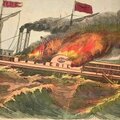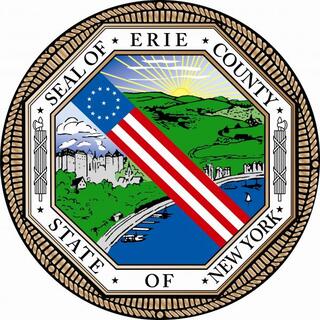By the late 1840s, Buffalo's maritime business was booming and local businessmen clamored for additional protected dockage for expansion. The land across the Buffalo River, bounded by the lake and sea wall, was the desired location. Slips had already been excavated from the Buffalo River. The Blackwell Canal, as it was called soon after construction, was later renamed the City Ship Canal. The Canal ended near Ohio Street (its end in 2014) despite the optimistic drawing above. In 1883 the city approved a request by the Buffalo Creek Railway to expand the canal all the way to the Tifft farm area. This was eventually used by the Lehigh Valley Railroad for coal docks. It would fall into disuse in the 1950s and be partially filled in. The remnants are part of the Tifft Farm Nature Preserve.
The new City Ship Canal created an instant expansion of businesses related to shipping. Four slips were cut joining the Buffalo River and the City Ship Canal. The part at the left (northern) tip (see the Watson Elevator image above) was commonly referred to as Kelly Island or "the island." The wooden Watson elevator burned in 1907. After that, the city purchased the land and turned it over to the U.S. government under an agreement that would dredge the area and create a turning basin, referred to for years as the Watson turning basin because the land on which elevator had stood was removed entirely.

Postcard image of the beginning of the City Ship Canal as seen from the harbor, 1915. Image source: private collection
The "new" Dakota Elevator, constructed of corrugated iron panels, above left, occupied the end of the land that divided the Buffalo River from the City Ship Canal. Behind it with the tapered top is the Frontier Elevator. Both structures were to be incorporated by the first big mill to come to Buffalo in 1903, Washburn-Crosby. The Minneapolis company already had a presence in Buffalo, leasing a warehouse on Fillmore Avenue at Clinton Street since 1889 which it used to store flour. But two factors in Buffalo's favor influenced Washburn-Crosby to build a flour mill in Buffalo. First, it was cheaper to ship wheat than it was flour via the Great Lakes and by rail. Second, favorable tariffs permitted Canadian wheat to be milled in the U.S. With its proximity and cross-border rail facilities, Buffalo was ideally suited for this.
Because Washburn Crosby built only a milling facility along the City Ship Canal, it contracted with the adjacent Frontier elevator for grain storage. The company was quickly successful and in 1907 purchased the Frontier Elevator and the Dakota Elevator. In 1908-09, it constructed two more mills and another elevator.

1906 photo of the Washburn Crosby mill as seen from across the City Ship Canal. Image source: Buffalo Today 1906-07
In 1925, the company constructed another elevator in the Frontier group. After purchasing a number of national milling companies, Washburn-Crosby became General Mills in 1928. By 1930, Buffalo surpassed Minneapolis as the flour milling center of the U.S.

Aerial view of the General Mills complex from the City Ship Canal perspective, c 1930s. Image source: Waterview Guide to the Buffalo Harbor.
In 1939, the company built new additions to the expansive facility. Fortunately for its desire for space, the Great Eastern Elevator, seen above at left, was nearing the end of its life. Cargill had purchased it in 1936 and demolished it in 1948.
Postcard showing the footprint of the General Mills plant, including the Dakota Elevator at left.

Postcard view from the early 1950's before the Skyway was built. The Dakota elevator still stands as well as the South Michigan Avenue bridge across the City Ship Canal. Image source: private collection.

The Dakota Elevator was demolished in 1965. In 1968, "A" and "B" mills were demolished and flour milling ceased in Buffalo. In 2014, the Buffalo General Mills plant manufactures Cheerios, Kix, Total, Lucky Charms, Wheaties, and bakery flour.
From 1988 until December 16, 2002, the facility received grain from the Kinsman Independent which made regular runs from Duluth to Buffalo. The Kinsman Independent is what is known as a straight deck bulk carrier, requiring shore side equipment for unloading. (Note how high the ship rests in the water in the image above; it is likely nearly empty of its grain cargo.) In 2002, General Mills installed an unloading hopper which meant that the facility would be able to accommodate self-unloading ships, increasing efficiency and saving money. The Kinsman Independent's last last trip to Buffalo brought 600,000 bushels of grain from Wisconsin. The ship was sold to an Ontario firm and is still operating. Other ships still make trips to Buffalo to provide grain for General Mills.
Special thanks to Brian Wroblewski for giving permission to display the above photo.
On September 23, 2014, the Buffalo News announced that General Mills is closing two plants, one in California that makes Cheerios, and the in Massachusetts. No mention of how this will affect the Buffalo plant, which employs 400 workers.
















